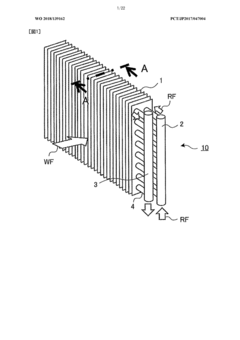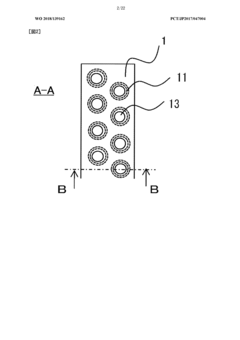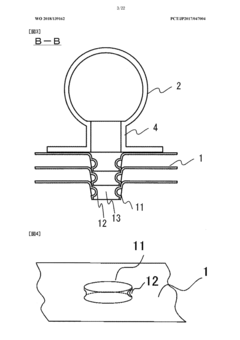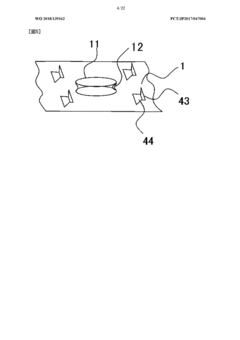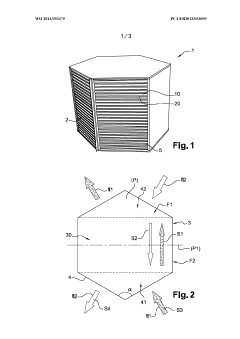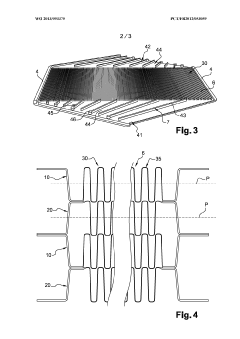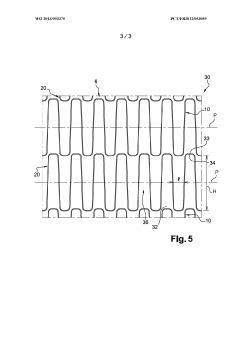Laminar Flow Analysis in Heat Exchanger Design
JUL 10, 20259 MIN READ
Generate Your Research Report Instantly with AI Agent
Patsnap Eureka helps you evaluate technical feasibility & market potential.
Laminar Flow Fundamentals and Objectives
Laminar flow analysis plays a crucial role in heat exchanger design, serving as the foundation for understanding fluid behavior and optimizing thermal performance. This fundamental concept in fluid dynamics describes the smooth, predictable motion of fluid particles in parallel layers without lateral mixing. In heat exchangers, laminar flow often occurs in specific regions or under certain operating conditions, significantly influencing heat transfer efficiency and overall system performance.
The primary objective of laminar flow analysis in heat exchanger design is to accurately predict and control fluid behavior to enhance heat transfer rates while minimizing pressure drop. By understanding the principles of laminar flow, engineers can develop more efficient and compact heat exchanger designs, tailored to specific applications across various industries, including power generation, chemical processing, and HVAC systems.
Historically, the study of laminar flow dates back to the 19th century, with pioneering work by George Gabriel Stokes and Osborne Reynolds. Their contributions laid the groundwork for modern fluid dynamics and heat transfer analysis. As technology has advanced, computational fluid dynamics (CFD) and advanced experimental techniques have revolutionized our ability to analyze and optimize laminar flow in complex heat exchanger geometries.
In recent years, the focus on laminar flow analysis has intensified due to the increasing demand for energy-efficient and environmentally friendly heat exchange systems. This has led to the development of novel heat exchanger designs that leverage laminar flow characteristics to achieve superior performance in low Reynolds number regimes. Micro-channel heat exchangers and laminar flow reactors are prime examples of innovations driven by a deeper understanding of laminar flow dynamics.
The technical goals of laminar flow analysis in heat exchanger design encompass several key areas. These include developing accurate mathematical models to predict laminar flow behavior in various channel geometries, optimizing surface features to enhance heat transfer without transitioning to turbulent flow, and creating design methodologies that balance heat transfer efficiency with pressure drop considerations.
Furthermore, researchers aim to extend the applicability of laminar flow heat exchangers to a broader range of operating conditions and fluids. This involves investigating the effects of temperature-dependent fluid properties, non-Newtonian fluids, and multi-phase flows on laminar heat transfer. By addressing these challenges, engineers can expand the use of laminar flow heat exchangers in emerging technologies such as fuel cells, electronic cooling systems, and advanced manufacturing processes.
As we delve deeper into the intricacies of laminar flow analysis, it becomes evident that this field continues to evolve, driven by technological advancements and the ever-growing need for more efficient thermal management solutions. The ongoing research and development in this area promise to unlock new possibilities in heat exchanger design, paving the way for more sustainable and high-performance thermal systems across various industries.
The primary objective of laminar flow analysis in heat exchanger design is to accurately predict and control fluid behavior to enhance heat transfer rates while minimizing pressure drop. By understanding the principles of laminar flow, engineers can develop more efficient and compact heat exchanger designs, tailored to specific applications across various industries, including power generation, chemical processing, and HVAC systems.
Historically, the study of laminar flow dates back to the 19th century, with pioneering work by George Gabriel Stokes and Osborne Reynolds. Their contributions laid the groundwork for modern fluid dynamics and heat transfer analysis. As technology has advanced, computational fluid dynamics (CFD) and advanced experimental techniques have revolutionized our ability to analyze and optimize laminar flow in complex heat exchanger geometries.
In recent years, the focus on laminar flow analysis has intensified due to the increasing demand for energy-efficient and environmentally friendly heat exchange systems. This has led to the development of novel heat exchanger designs that leverage laminar flow characteristics to achieve superior performance in low Reynolds number regimes. Micro-channel heat exchangers and laminar flow reactors are prime examples of innovations driven by a deeper understanding of laminar flow dynamics.
The technical goals of laminar flow analysis in heat exchanger design encompass several key areas. These include developing accurate mathematical models to predict laminar flow behavior in various channel geometries, optimizing surface features to enhance heat transfer without transitioning to turbulent flow, and creating design methodologies that balance heat transfer efficiency with pressure drop considerations.
Furthermore, researchers aim to extend the applicability of laminar flow heat exchangers to a broader range of operating conditions and fluids. This involves investigating the effects of temperature-dependent fluid properties, non-Newtonian fluids, and multi-phase flows on laminar heat transfer. By addressing these challenges, engineers can expand the use of laminar flow heat exchangers in emerging technologies such as fuel cells, electronic cooling systems, and advanced manufacturing processes.
As we delve deeper into the intricacies of laminar flow analysis, it becomes evident that this field continues to evolve, driven by technological advancements and the ever-growing need for more efficient thermal management solutions. The ongoing research and development in this area promise to unlock new possibilities in heat exchanger design, paving the way for more sustainable and high-performance thermal systems across various industries.
Heat Exchanger Market Trends
The global heat exchanger market has been experiencing steady growth, driven by increasing industrialization, urbanization, and the growing demand for energy-efficient systems. The market is expected to continue its upward trajectory, with a significant focus on innovative designs and materials that enhance heat transfer efficiency and reduce environmental impact.
One of the key trends shaping the heat exchanger market is the rising adoption of plate heat exchangers. These compact and efficient units are gaining popularity across various industries due to their superior heat transfer capabilities and ease of maintenance. The automotive sector, in particular, has been a major contributor to this trend, as manufacturers seek to improve vehicle thermal management systems.
Another notable trend is the increasing demand for heat exchangers in the HVAC industry. As energy efficiency regulations become more stringent worldwide, there is a growing need for advanced heat exchanger designs that can optimize heating and cooling processes in buildings. This has led to the development of more sophisticated heat recovery systems and the integration of smart technologies for better control and monitoring.
The oil and gas industry continues to be a significant driver of the heat exchanger market. With the expansion of refining capacities and the need for efficient process heat management, there is a growing demand for specialized heat exchangers that can withstand harsh operating conditions and corrosive environments.
Sustainability and environmental concerns are also influencing market trends. There is a growing emphasis on the use of eco-friendly refrigerants and materials in heat exchanger manufacturing. This has led to increased research and development efforts focused on creating more sustainable and energy-efficient heat exchange solutions.
In terms of regional dynamics, Asia-Pacific is emerging as a key growth market for heat exchangers. Rapid industrialization in countries like China and India, coupled with increasing investments in infrastructure development, is driving the demand for heat exchange equipment across various sectors.
The market is also witnessing a shift towards customized and application-specific heat exchanger designs. As industries face unique thermal management challenges, there is a growing need for tailored solutions that can meet specific performance requirements and operating conditions.
Technological advancements in manufacturing processes, such as 3D printing and advanced welding techniques, are enabling the production of more complex and efficient heat exchanger designs. These innovations are expected to play a crucial role in shaping the future of the heat exchanger market, allowing for the creation of more compact, lightweight, and high-performance units.
One of the key trends shaping the heat exchanger market is the rising adoption of plate heat exchangers. These compact and efficient units are gaining popularity across various industries due to their superior heat transfer capabilities and ease of maintenance. The automotive sector, in particular, has been a major contributor to this trend, as manufacturers seek to improve vehicle thermal management systems.
Another notable trend is the increasing demand for heat exchangers in the HVAC industry. As energy efficiency regulations become more stringent worldwide, there is a growing need for advanced heat exchanger designs that can optimize heating and cooling processes in buildings. This has led to the development of more sophisticated heat recovery systems and the integration of smart technologies for better control and monitoring.
The oil and gas industry continues to be a significant driver of the heat exchanger market. With the expansion of refining capacities and the need for efficient process heat management, there is a growing demand for specialized heat exchangers that can withstand harsh operating conditions and corrosive environments.
Sustainability and environmental concerns are also influencing market trends. There is a growing emphasis on the use of eco-friendly refrigerants and materials in heat exchanger manufacturing. This has led to increased research and development efforts focused on creating more sustainable and energy-efficient heat exchange solutions.
In terms of regional dynamics, Asia-Pacific is emerging as a key growth market for heat exchangers. Rapid industrialization in countries like China and India, coupled with increasing investments in infrastructure development, is driving the demand for heat exchange equipment across various sectors.
The market is also witnessing a shift towards customized and application-specific heat exchanger designs. As industries face unique thermal management challenges, there is a growing need for tailored solutions that can meet specific performance requirements and operating conditions.
Technological advancements in manufacturing processes, such as 3D printing and advanced welding techniques, are enabling the production of more complex and efficient heat exchanger designs. These innovations are expected to play a crucial role in shaping the future of the heat exchanger market, allowing for the creation of more compact, lightweight, and high-performance units.
Laminar Flow Challenges in Heat Exchangers
Laminar flow in heat exchangers presents significant challenges that impact the overall efficiency and performance of these critical components. One of the primary issues is the formation of boundary layers near the heat transfer surfaces. These layers act as thermal insulators, reducing the rate of heat transfer between the fluid and the exchanger walls. As the flow remains laminar, mixing is minimal, leading to temperature gradients within the fluid that further impede efficient heat exchange.
Another challenge is the difficulty in predicting and controlling the flow distribution within the heat exchanger. Laminar flow is highly sensitive to geometry and inlet conditions, making it challenging to ensure uniform flow across all channels or tubes. This non-uniformity can result in localized hot spots or cold regions, compromising the exchanger's overall effectiveness and potentially leading to thermal stress or material fatigue.
The low Reynolds numbers associated with laminar flow also limit the heat transfer coefficient. This limitation necessitates larger heat transfer areas to achieve the desired thermal performance, potentially increasing the size and cost of the heat exchanger. Additionally, the reduced turbulence in laminar flow diminishes the scouring effect that helps prevent fouling and scaling on heat transfer surfaces, potentially leading to decreased performance over time and increased maintenance requirements.
Pressure drop considerations pose another significant challenge in laminar flow heat exchangers. While laminar flow generally results in lower pressure drops compared to turbulent flow, the need for extended flow paths to compensate for lower heat transfer rates can lead to increased overall pressure losses. This trade-off between heat transfer enhancement and pressure drop must be carefully balanced to optimize system efficiency.
The transition region between laminar and turbulent flow presents its own set of challenges. Near the critical Reynolds number, flow behavior becomes unpredictable, potentially leading to instabilities in heat transfer rates and pressure drops. Designing heat exchangers that operate consistently in the laminar regime while avoiding this transitional zone requires precise engineering and may limit operational flexibility.
Lastly, the analytical and numerical modeling of laminar flow in complex heat exchanger geometries can be computationally intensive. Accurate simulation of fluid dynamics and heat transfer in intricate channel designs often requires sophisticated CFD tools and significant computational resources. This complexity can extend design cycles and increase development costs for advanced heat exchanger configurations optimized for laminar flow conditions.
Another challenge is the difficulty in predicting and controlling the flow distribution within the heat exchanger. Laminar flow is highly sensitive to geometry and inlet conditions, making it challenging to ensure uniform flow across all channels or tubes. This non-uniformity can result in localized hot spots or cold regions, compromising the exchanger's overall effectiveness and potentially leading to thermal stress or material fatigue.
The low Reynolds numbers associated with laminar flow also limit the heat transfer coefficient. This limitation necessitates larger heat transfer areas to achieve the desired thermal performance, potentially increasing the size and cost of the heat exchanger. Additionally, the reduced turbulence in laminar flow diminishes the scouring effect that helps prevent fouling and scaling on heat transfer surfaces, potentially leading to decreased performance over time and increased maintenance requirements.
Pressure drop considerations pose another significant challenge in laminar flow heat exchangers. While laminar flow generally results in lower pressure drops compared to turbulent flow, the need for extended flow paths to compensate for lower heat transfer rates can lead to increased overall pressure losses. This trade-off between heat transfer enhancement and pressure drop must be carefully balanced to optimize system efficiency.
The transition region between laminar and turbulent flow presents its own set of challenges. Near the critical Reynolds number, flow behavior becomes unpredictable, potentially leading to instabilities in heat transfer rates and pressure drops. Designing heat exchangers that operate consistently in the laminar regime while avoiding this transitional zone requires precise engineering and may limit operational flexibility.
Lastly, the analytical and numerical modeling of laminar flow in complex heat exchanger geometries can be computationally intensive. Accurate simulation of fluid dynamics and heat transfer in intricate channel designs often requires sophisticated CFD tools and significant computational resources. This complexity can extend design cycles and increase development costs for advanced heat exchanger configurations optimized for laminar flow conditions.
Current Laminar Flow Modeling Techniques
01 Heat exchanger design optimization
Optimization of heat exchanger designs to improve flow characteristics and thermal efficiency. This includes modifications to the structure, geometry, and materials used in heat exchangers to enhance heat transfer rates and reduce pressure drops.- Heat exchanger design optimization: Optimization of heat exchanger designs to improve flow characteristics and thermal efficiency. This includes modifications to the structure, geometry, and arrangement of heat transfer surfaces to enhance heat transfer rates and reduce pressure drops.
- Flow control mechanisms: Implementation of various flow control mechanisms in heat exchangers to regulate and distribute fluid flow effectively. This may involve the use of baffles, distributors, or other flow directing devices to ensure uniform distribution and optimal heat transfer.
- Multi-phase flow management: Techniques for managing multi-phase flows in heat exchangers, addressing challenges associated with gas-liquid or liquid-liquid flows. This includes methods to prevent phase separation, reduce flow instabilities, and enhance overall heat transfer efficiency in multi-phase systems.
- Smart control systems for heat exchangers: Integration of intelligent control systems and sensors to monitor and optimize heat exchanger performance in real-time. These systems can adjust flow rates, temperatures, and other parameters based on changing operating conditions to maintain optimal efficiency.
- Novel heat exchanger configurations: Development of innovative heat exchanger configurations and geometries to improve flow distribution and heat transfer. This includes compact designs, modular systems, and unconventional flow arrangements that can enhance performance in specific applications.
02 Flow control mechanisms in heat exchangers
Implementation of various flow control mechanisms to regulate and optimize fluid flow within heat exchangers. This may involve the use of baffles, fins, or other flow directing devices to improve heat transfer and reduce flow resistance.Expand Specific Solutions03 Multi-phase flow in heat exchangers
Management and optimization of multi-phase flow in heat exchangers, including gas-liquid or liquid-liquid flows. This involves addressing issues such as phase separation, flow distribution, and heat transfer enhancement in multi-phase systems.Expand Specific Solutions04 Smart control systems for heat exchanger flow
Integration of smart control systems and sensors to monitor and regulate flow in heat exchangers. This includes the use of advanced algorithms, machine learning, and real-time data analysis to optimize flow conditions and overall heat exchanger performance.Expand Specific Solutions05 Novel heat exchanger configurations for improved flow
Development of innovative heat exchanger configurations and geometries to enhance flow characteristics. This may include the use of microchannels, 3D-printed structures, or other advanced designs to improve heat transfer efficiency and reduce flow-related issues.Expand Specific Solutions
Key Players in Heat Exchanger Industry
The laminar flow analysis in heat exchanger design market is in a mature stage, with established players and well-developed technologies. The global heat exchanger market size is projected to reach $28.5 billion by 2026, driven by increasing demand across industries. Technologically, laminar flow analysis has advanced significantly, with companies like Daikin, Mitsubishi Electric, and Bosch leading innovation. Academic institutions such as Tsinghua University and Xi'an Jiaotong University contribute cutting-edge research. The competitive landscape includes diverse players from automotive (Toyota, Honda), electronics (Panasonic, LG), and specialized heat exchanger manufacturers (Miura), indicating widespread application and ongoing refinement of laminar flow analysis techniques in heat exchanger design.
Tsinghua University
Technical Solution: Tsinghua University has developed advanced computational fluid dynamics (CFD) models for laminar flow analysis in heat exchanger design. Their approach combines high-fidelity numerical simulations with experimental validation to optimize heat transfer efficiency. The university's research team has implemented a multi-scale modeling technique that captures both macro-level flow patterns and micro-level boundary layer effects[1]. This method allows for accurate prediction of pressure drop and heat transfer coefficients in complex geometries. Additionally, they have integrated machine learning algorithms to accelerate the design process, enabling rapid iteration and optimization of heat exchanger configurations[3].
Strengths: Cutting-edge research capabilities, integration of AI for design optimization. Weaknesses: Potential gap between academic research and industrial application, may require partnerships for commercialization.
DAIKIN INDUSTRIES Ltd.
Technical Solution: DAIKIN has developed a proprietary laminar flow control system for their heat exchangers, focusing on HVAC applications. Their approach utilizes micro-channel technology combined with advanced surface treatments to enhance heat transfer in laminar flow regimes. The company has implemented a novel fin design that promotes uniform flow distribution, reducing dead zones and improving overall thermal performance[2]. DAIKIN's system also incorporates adaptive flow control mechanisms that adjust to varying load conditions, maintaining optimal laminar flow characteristics across a wide range of operating parameters[4]. This technology has been successfully applied in their latest generation of air conditioning units, achieving up to 15% improvement in energy efficiency compared to conventional designs.
Strengths: Strong market presence in HVAC, practical implementation of advanced technologies. Weaknesses: Primarily focused on HVAC applications, may have limited expertise in other heat exchanger domains.
Innovative Laminar Flow Research
Heat exchanger
PatentWO2018139162A1
Innovation
- The heat exchanger design incorporates plate-shaped fins with tapered cylindrical collar portions and second fins that are discontinuous in the circumferential direction, creating gaps that reduce flow resistance and enhance the leading edge effect, improving heat transfer even in laminar flow conditions by increasing the heat transfer area and promoting turbulence.
Plate for heat exchanger
PatentWO2013093375A1
Innovation
- The plate design features a core zone with undulations forming cavities and entry/exit zones with ribs and grooves, orienting the fluid flow transversely, concentrating pressure drops within the core zone and reducing them at inlets and outlets, while alternating plate types in the stack enhances fluid interpenetration and heat exchange.
Energy Efficiency Considerations
Energy efficiency is a critical consideration in the design and optimization of heat exchangers, particularly when analyzing laminar flow conditions. The careful management of energy transfer within these systems can lead to significant improvements in overall performance and operational costs.
In laminar flow regimes, the fluid moves in parallel layers without lateral mixing, which can impact heat transfer rates. This characteristic necessitates a thoughtful approach to energy efficiency. One key strategy involves maximizing the surface area for heat exchange while minimizing pressure drop. This can be achieved through the use of enhanced surfaces, such as fins or corrugated plates, which increase turbulence at the fluid-solid interface without disrupting the overall laminar flow pattern.
The selection of materials for heat exchanger construction plays a crucial role in energy efficiency. Materials with high thermal conductivity, such as copper or aluminum, facilitate rapid heat transfer between fluids. However, the trade-off between thermal performance and cost must be carefully evaluated. In some cases, composite materials or advanced alloys may offer an optimal balance of efficiency and economic viability.
Flow arrangement is another vital aspect of energy-efficient design in laminar flow heat exchangers. Counter-flow configurations typically yield higher effectiveness compared to parallel flow arrangements. This is because counter-flow maintains a more consistent temperature difference along the length of the exchanger, maximizing the driving force for heat transfer.
Temperature control and fluid distribution are essential for maintaining energy efficiency in laminar flow conditions. Uniform fluid distribution across the heat transfer surface prevents the formation of stagnant zones or bypasses, which can significantly reduce efficiency. Additionally, precise temperature control helps maintain the desired laminar flow regime and ensures optimal heat transfer rates.
The integration of passive enhancement techniques can further improve energy efficiency without introducing additional energy inputs. These may include the use of twisted tape inserts, wire coil inserts, or dimpled surfaces. Such modifications can induce secondary flows and vortices that enhance mixing and heat transfer while maintaining overall laminar characteristics.
Computational fluid dynamics (CFD) simulations have become invaluable tools for optimizing energy efficiency in heat exchanger design. These simulations allow engineers to model complex flow patterns and heat transfer processes, enabling the identification of inefficiencies and the testing of various design iterations without the need for physical prototypes.
In conclusion, achieving high energy efficiency in heat exchangers with laminar flow requires a multifaceted approach. By carefully considering factors such as surface enhancement, material selection, flow arrangement, and passive enhancement techniques, designers can create systems that maximize heat transfer while minimizing energy consumption. The ongoing development of advanced materials and simulation tools continues to push the boundaries of what is possible in energy-efficient heat exchanger design.
In laminar flow regimes, the fluid moves in parallel layers without lateral mixing, which can impact heat transfer rates. This characteristic necessitates a thoughtful approach to energy efficiency. One key strategy involves maximizing the surface area for heat exchange while minimizing pressure drop. This can be achieved through the use of enhanced surfaces, such as fins or corrugated plates, which increase turbulence at the fluid-solid interface without disrupting the overall laminar flow pattern.
The selection of materials for heat exchanger construction plays a crucial role in energy efficiency. Materials with high thermal conductivity, such as copper or aluminum, facilitate rapid heat transfer between fluids. However, the trade-off between thermal performance and cost must be carefully evaluated. In some cases, composite materials or advanced alloys may offer an optimal balance of efficiency and economic viability.
Flow arrangement is another vital aspect of energy-efficient design in laminar flow heat exchangers. Counter-flow configurations typically yield higher effectiveness compared to parallel flow arrangements. This is because counter-flow maintains a more consistent temperature difference along the length of the exchanger, maximizing the driving force for heat transfer.
Temperature control and fluid distribution are essential for maintaining energy efficiency in laminar flow conditions. Uniform fluid distribution across the heat transfer surface prevents the formation of stagnant zones or bypasses, which can significantly reduce efficiency. Additionally, precise temperature control helps maintain the desired laminar flow regime and ensures optimal heat transfer rates.
The integration of passive enhancement techniques can further improve energy efficiency without introducing additional energy inputs. These may include the use of twisted tape inserts, wire coil inserts, or dimpled surfaces. Such modifications can induce secondary flows and vortices that enhance mixing and heat transfer while maintaining overall laminar characteristics.
Computational fluid dynamics (CFD) simulations have become invaluable tools for optimizing energy efficiency in heat exchanger design. These simulations allow engineers to model complex flow patterns and heat transfer processes, enabling the identification of inefficiencies and the testing of various design iterations without the need for physical prototypes.
In conclusion, achieving high energy efficiency in heat exchangers with laminar flow requires a multifaceted approach. By carefully considering factors such as surface enhancement, material selection, flow arrangement, and passive enhancement techniques, designers can create systems that maximize heat transfer while minimizing energy consumption. The ongoing development of advanced materials and simulation tools continues to push the boundaries of what is possible in energy-efficient heat exchanger design.
Computational Fluid Dynamics Applications
Computational Fluid Dynamics (CFD) has revolutionized the analysis and design of heat exchangers, particularly in the realm of laminar flow analysis. This advanced simulation technique allows engineers to model and predict fluid behavior within complex geometries, providing invaluable insights into heat transfer processes and flow characteristics.
In the context of heat exchanger design, CFD applications have become indispensable for optimizing performance and efficiency. By simulating laminar flow conditions, engineers can accurately predict temperature distributions, pressure drops, and heat transfer coefficients across various heat exchanger configurations. This level of detail enables the identification of potential hotspots, areas of poor mixing, or regions with suboptimal heat transfer, leading to more informed design decisions.
One of the key advantages of CFD in laminar flow analysis is its ability to handle intricate geometries that are common in modern heat exchanger designs. From plate heat exchangers to shell-and-tube configurations, CFD can model the fluid dynamics in these complex structures with high fidelity. This capability is particularly crucial when dealing with compact heat exchangers or those with enhanced surfaces, where traditional analytical methods may fall short.
Moreover, CFD simulations allow for the exploration of various operating conditions and fluid properties without the need for costly physical prototypes. Engineers can easily adjust parameters such as flow rates, fluid viscosities, and thermal conductivities to assess their impact on heat exchanger performance. This virtual experimentation accelerates the design iteration process and reduces development costs significantly.
The application of CFD in laminar flow analysis also extends to the optimization of flow distribution within heat exchangers. By visualizing flow patterns and velocity profiles, engineers can identify and mitigate issues such as flow maldistribution or dead zones, which can severely impact heat transfer efficiency. This level of insight is particularly valuable in designing header configurations and baffle arrangements in shell-and-tube heat exchangers.
Furthermore, CFD simulations provide a platform for investigating the effects of fouling and scaling on heat exchanger performance over time. By incorporating models for particle deposition or chemical reactions, engineers can predict long-term performance degradation and develop strategies for maintenance and cleaning schedules.
As computational power continues to increase, the role of CFD in heat exchanger design is expected to expand further. Advanced techniques such as multiphase flow modeling and conjugate heat transfer analysis are becoming more accessible, enabling even more comprehensive simulations of heat exchanger systems. These developments promise to drive innovation in heat exchanger technology, leading to more efficient and sustainable designs across various industries.
In the context of heat exchanger design, CFD applications have become indispensable for optimizing performance and efficiency. By simulating laminar flow conditions, engineers can accurately predict temperature distributions, pressure drops, and heat transfer coefficients across various heat exchanger configurations. This level of detail enables the identification of potential hotspots, areas of poor mixing, or regions with suboptimal heat transfer, leading to more informed design decisions.
One of the key advantages of CFD in laminar flow analysis is its ability to handle intricate geometries that are common in modern heat exchanger designs. From plate heat exchangers to shell-and-tube configurations, CFD can model the fluid dynamics in these complex structures with high fidelity. This capability is particularly crucial when dealing with compact heat exchangers or those with enhanced surfaces, where traditional analytical methods may fall short.
Moreover, CFD simulations allow for the exploration of various operating conditions and fluid properties without the need for costly physical prototypes. Engineers can easily adjust parameters such as flow rates, fluid viscosities, and thermal conductivities to assess their impact on heat exchanger performance. This virtual experimentation accelerates the design iteration process and reduces development costs significantly.
The application of CFD in laminar flow analysis also extends to the optimization of flow distribution within heat exchangers. By visualizing flow patterns and velocity profiles, engineers can identify and mitigate issues such as flow maldistribution or dead zones, which can severely impact heat transfer efficiency. This level of insight is particularly valuable in designing header configurations and baffle arrangements in shell-and-tube heat exchangers.
Furthermore, CFD simulations provide a platform for investigating the effects of fouling and scaling on heat exchanger performance over time. By incorporating models for particle deposition or chemical reactions, engineers can predict long-term performance degradation and develop strategies for maintenance and cleaning schedules.
As computational power continues to increase, the role of CFD in heat exchanger design is expected to expand further. Advanced techniques such as multiphase flow modeling and conjugate heat transfer analysis are becoming more accessible, enabling even more comprehensive simulations of heat exchanger systems. These developments promise to drive innovation in heat exchanger technology, leading to more efficient and sustainable designs across various industries.
Unlock deeper insights with Patsnap Eureka Quick Research — get a full tech report to explore trends and direct your research. Try now!
Generate Your Research Report Instantly with AI Agent
Supercharge your innovation with Patsnap Eureka AI Agent Platform!
